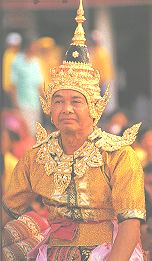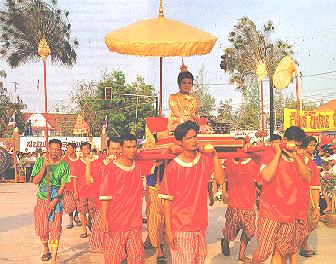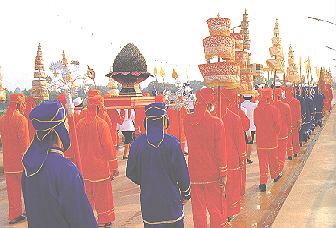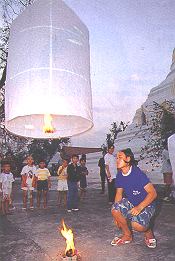|
- Historical evidence shows that Kamphaeng Phet, an ancient city, is older than the Sukhothai Kingdom. Buddha images of the Dvaravati Period of 1,000 years old have been discovered at the Kathing Temple in Kamphaeng Phet.
significance in Khu Bua Sub-district of Muang District, Ratchaburi. The mystic and enchanting Dvaravati civilisation is reflected in many cities in
Thailand.

The actor Phya Lithai in the procession
- Kamphaeng Phet is believed to have been built by King Loethai of the Sukhothai Period in the 13th century, when it had the name of Chakangrao, located on the east bank of the Ping River.
Lter King Thammaracha I or Lithai (1347 - 3174) built another city, called Nakhon Chum, on the west bank.

The procession of princes
- The Ping River caused erosion to the banks of Nakhon Chum, which perhaps often faced flooding. Nakhon Chum was, thus, relocated to the east bank of the Ping River and was named Chakangrao or Kamphaeng Phet.
After the reign of King Thammaracha I, Kamphaeng Phet became a major fortified town of the Sukhothai Kingdom.
- Looking back 600 years, it was the golden era of Buddhism, King Lithai of the Sukhothai Period then wrote the 'Traiphummikatha' describing the tree planes of existence in the Buddhism cosmology.
Around 1357, King Lithai brought the holy relics of the Lord Buddha from Sri Lanka to be enshrined in the pagoda of Wat Phra Borommathat Chediyaram, now located in Nakhon Chum Sub-district, Muang Diatrict of Kamphaeng Phet Province.

The procession of the royal consort and daughter

The procession of offerings for Buddha
- A Bo tree (a species of trees under which the Buddha attained enlightenment) was also brought to be planted at the rear of the pagoda. On the full moon day of the third lunar month, or Magha Pucha Day, the King, princes, city rulers,
royal retinue and the general public formed a procession to play homage to the Lord Buddha's holy relics at Wat Phra Borommathat Nakhon Chum. This homage-paying ceremony is commonly referred to as "Nop Phra".
- Because of the difficulties in transport and communications in those days, people who joined the procession to pay homage to the holy relics had to stay overnight in the temple compound before returning home the following morning.
When people from different localities gathered in the same area, they joined hands in staging various folk shows, and playing music. These performances are called "Len Phleng".

Floating lamps flickering away in the sky, a way of worshipping Lord Buddha
|
Top
|
|
Return to the main page
|

